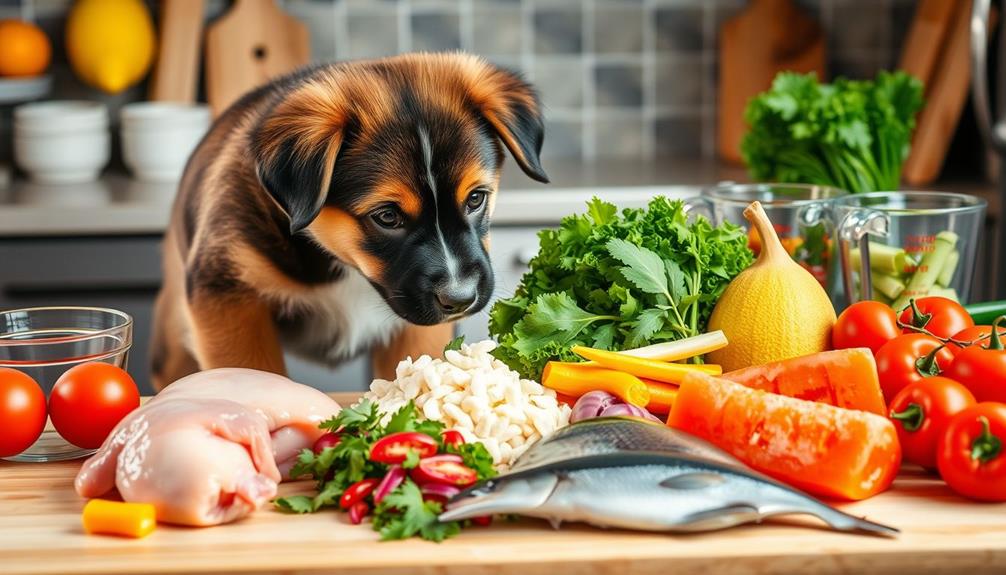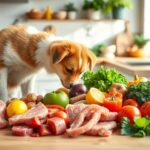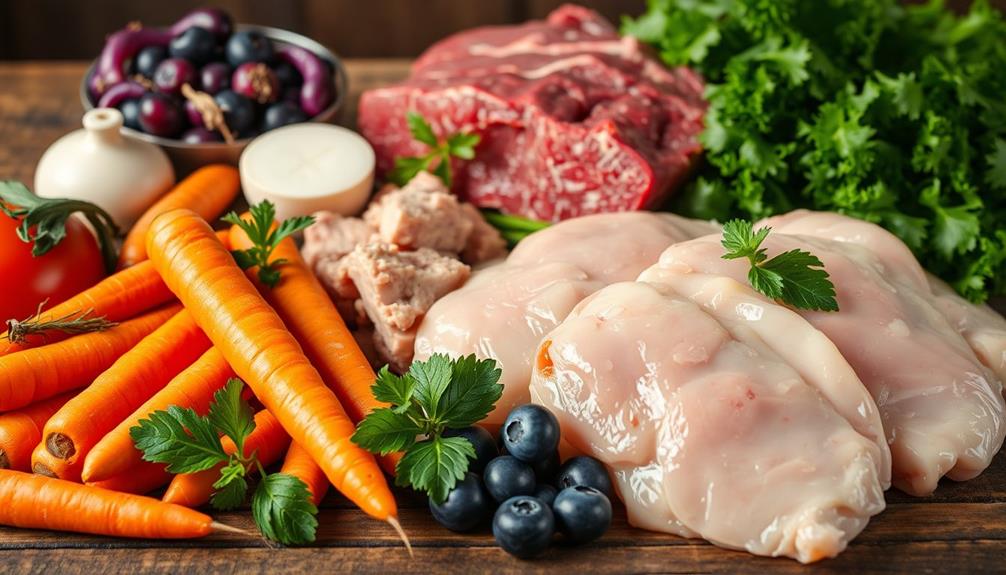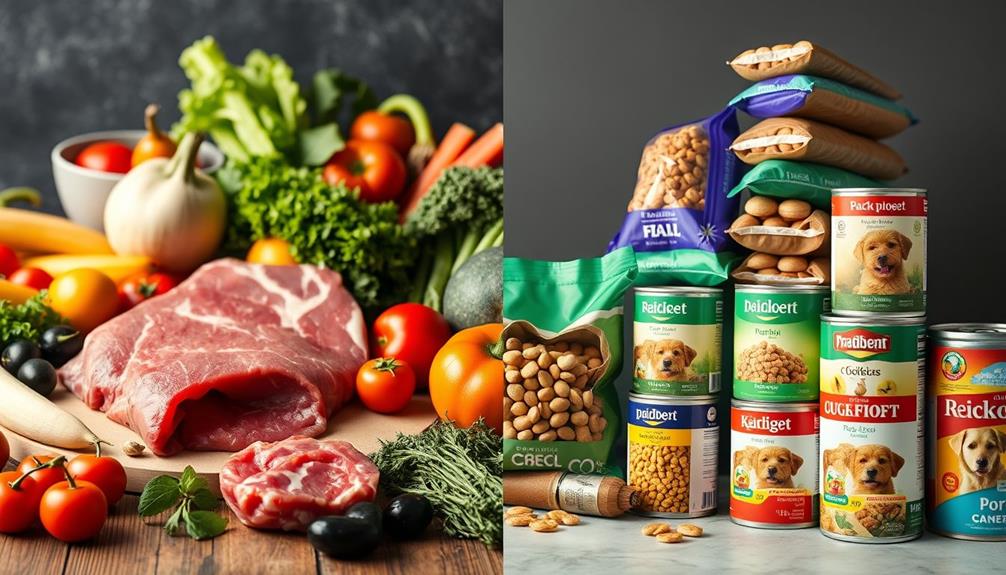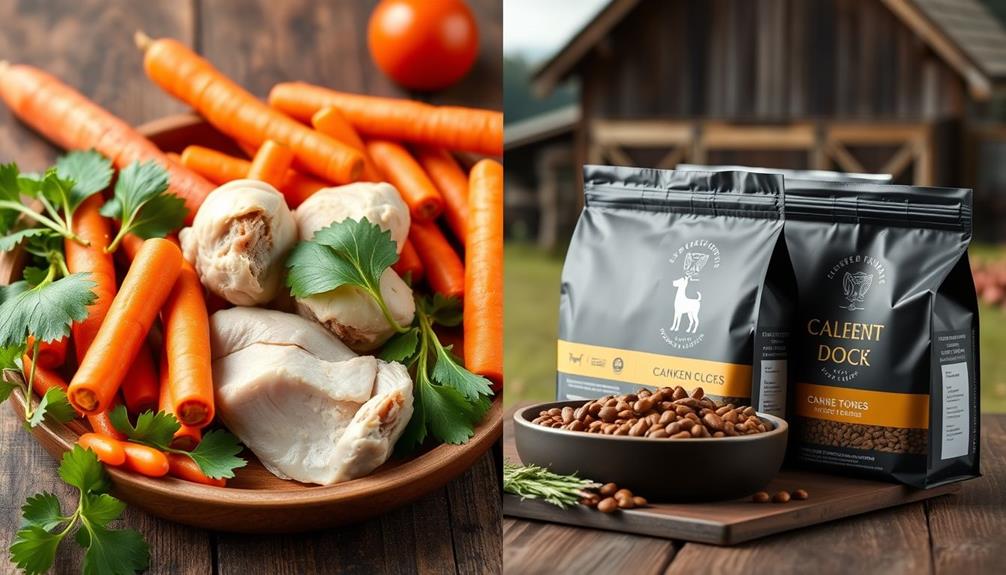Feeding your puppy raw food can boost their health and vitality. Start with a balanced diet of 58% muscle meat, 17% raw edible bone, and a mix of organ meats and vegetables. Shift gradually from their current diet to prevent stomach upset. For puppies under six months, feed about 10% of their body weight spread over four meals daily, then adjust as they grow. Monitor their weight, health, and stool consistency to guarantee they're thriving. Remember, using high-quality ingredients is essential for their well-being. If you want even more important tips and guidelines, just keep exploring!
Key Takeaways
- Begin with a cold turkey switch after weaning, ensuring a balanced diet of 58% muscle meat, 17% raw edible bone, and 10-25% organ meats.
- Introduce new protein sources gradually to monitor any gastrointestinal reactions and adjust feeding amounts based on growth and activity levels.
- Maintain a feeding schedule: four meals for puppies 8-16 weeks, three meals until 12 months, and two meals thereafter.
- Regularly assess body condition and stool consistency to ensure proper nutrition and adjust diet as needed.
- Source high-quality ingredients from trusted suppliers, and follow strict hygiene practices to minimize health risks.
Overview of Raw Feeding
When considering a feeding method for your puppy, raw feeding, often referred to as the BARF diet, stands out as a natural choice. This diet mimics the food that wild canines eat, emphasizing the inclusion of raw meats, bones, fruits, and vegetables.
For a balanced diet, you'll want to incorporate about 58% muscle meat, 17% raw edible bone, and 7% each of vegetables, liver, and other organ meats. To keep your puppy engaged and satisfied, you might also want to explore healthy dog snacks that complement their raw diet.
Starting your puppy on a raw diet can happen right after weaning, and a cold turkey switch is often best for their developing digestive systems. Unlike adult dogs, puppies require higher amounts of essential nutrients such as protein, calcium, and vitamins to support their growth.
It's also important to guarantee you're sourcing high-quality raw ingredients and preparing them safely to prevent any health issues.
Monitoring your puppy's health and stool consistency will help you confirm they're getting a balanced diet and not experiencing digestive upset. By following these guidelines, you can provide your puppy with the nutrients they need while enjoying the benefits that come with raw feeding.
Benefits of Raw Diet

Raw feeding offers numerous advantages for your puppy's health and development. By opting for a raw diet, you provide essential nutrients that support rapid growth. High-quality protein sources are essential for muscle development and energy levels, giving your puppy a strong foundation. Furthermore, biologically appropriate raw food enhances nutrient absorption, reducing the risk of health issues like allergies and diabetes.
Additionally, fresh, raw diets promote a healthier coat and skin. The natural oils and essential fatty acids contribute to improved overall appearance and health. You'll likely notice smaller, firmer stools, indicating better digestion and nutrient utilization, while also reducing flatulence.
The benefits don't stop there! The natural enzymes and probiotics found in raw diets support digestive health, boosting your puppy's immune system and promoting longevity.
Here's a quick overview of the benefits:
| Benefit | Description |
|---|---|
| Essential Nutrients | Supports rapid growth and energy levels |
| High-Quality Protein | critical for muscle development |
| Healthier Coat | Natural oils improve skin and coat appearance |
| Smaller Stool | Indicates better digestion and nutrient use |
Nutritional Requirements for Puppies
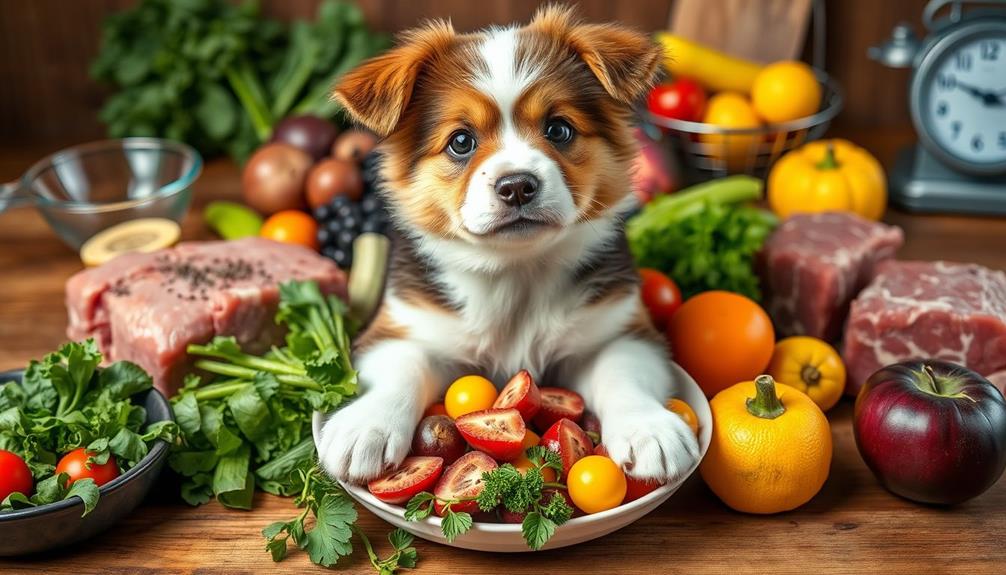
When feeding your puppy, it's vital to understand their unique nutritional requirements.
They need a balanced diet that supports their rapid growth, with specific ratios of muscle meat, bones, and organ meat.
A well-structured diet can help avoid financial mistakes to avoid that arise from unexpected veterinary costs.
Essential Nutritional Components
Puppies thrive on a balanced diet that fuels their rapid growth and playful energy. For optimal health, your puppy's diet should consist of about 58% muscle meat, 17% raw edible bone, 7% vegetables, and 10-25% organ meats, including liver and other secreting organs.
These organ meats are essential as they provide important nutrients like fat-soluble vitamins and minerals. Proper diet for pets is crucial for their overall well-being. High-quality protein is critical for muscle development, while calcium and phosphorus from bones help build strong bones.
To guarantee your puppy gets the right balance, aim for a daily intake that accounts for 4%-10% of their body weight, adjusting as needed based on age and activity level. Younger puppies typically require a higher percentage.
When introducing new protein sources, do so gradually. Monitor your puppy's reactions and stool consistency to confirm their nutrient intake remains balanced.
Growth Stage Considerations
As your puppy grows, understanding their changing nutritional requirements becomes essential for guaranteeing peak health. In the first few days, younger puppies typically need about 10% of their body weight in food daily. As they mature, this percentage decreases; by the time your puppy is six months old, you'll only need to provide around 4%.
It's important to remember that a balanced diet can greatly impact your puppy's long-term health, especially during their critical growth phases, as proper nutrition lays the foundation for a strong immune system and overall vitality. This is akin to the benefits of antioxidants for health seen in juice diets.
Feeding your puppy a balanced raw diet is vital. This should consist of 58-71% muscle meat, 15-20% raw edible bones, and 10-14% organ meats. This combination guarantees they receive the essential nutrients, vitamins, and minerals necessary for healthy development.
It's also important to feed your puppy multiple meals throughout the day—four meals for those aged 8-16 weeks, moving to three meals until 12 months, and then reducing to two meals thereafter.
Regularly monitor your puppy's weight and make adjustments to their food intake based on their growth rate and activity level. This practice will help you avoid overfeeding or underfeeding, leading to a balanced and healthy adult dog.
Balanced Diet Ratios
Feeding your puppy a balanced raw diet is fundamental for their healthy growth and development. To achieve the right balanced diet ratios, aim for approximately 69-71% muscle meat, 15-17% raw meaty bone, 7% liver, and 7% other organ meats. This combination helps meet their nutritional requirements effectively.
Incorporating a variety of nutrient-rich foods is essential for your puppy's overall health, as it promotes a strong immune system and supports proper organ function. A focus on effective strategies for weight loss can also be beneficial in managing your puppy's weight as they grow.
Make certain you provide a higher percentage of raw meaty bone (15-20%) compared to adult dogs, as this is important for supplying the calcium and phosphorus necessary for healthy bone development.
Calculate the recommended daily intake based on your puppy's weight, ideally around 8-10% of their body weight, and adjust as they grow.
It's also important to introduce a variety of at least four protein sources, focusing on red meats for superior nutrition. Increasing the ratio of organ meats is crucial too, as puppies have higher vitamin and mineral needs.
Liver should constitute about 5-10% of their daily allowance to support these needs. By adhering to these balanced diet ratios, you'll help guarantee your puppy thrives on a raw food diet.
Transitioning to Raw Food
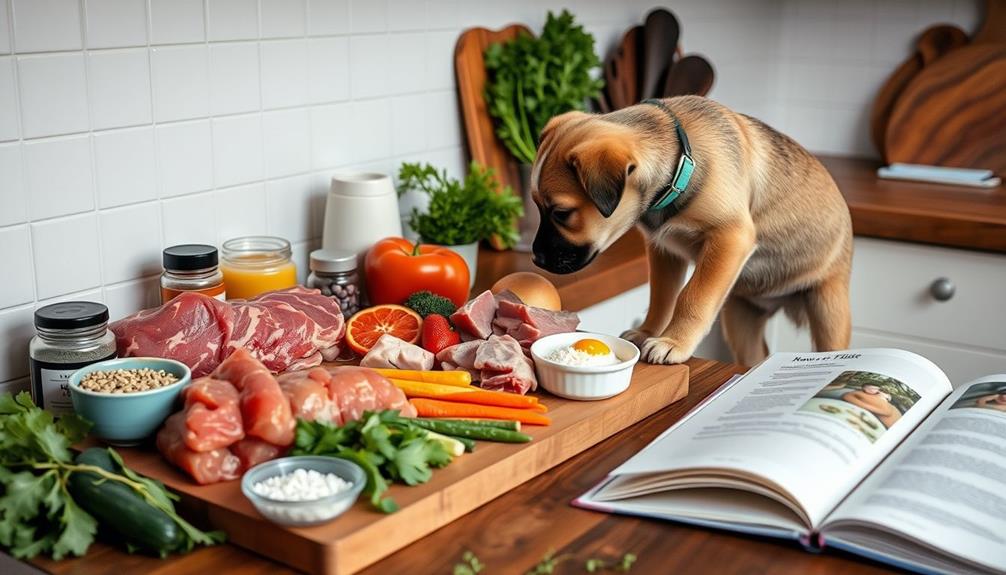
Shifting to a raw food diet can be an exciting journey for both you and your new puppy. Begin altering immediately by mixing 20% raw food with 80% of their current diet. It's important to select the right diet for your puppy's health and growth considering their specific nutritional needs.
Increase the raw percentage weekly until your puppy is fully on raw food, typically within 7-10 days. When introducing raw food, start with one protein source at a time. This allows you to monitor any signs of gastrointestinal issues before adding new proteins or bones.
Puppies under one year often handle a cold turkey switch to raw food, while older dogs may need a more gradual approach. Pay close attention to your puppy's stool consistency during the alteration. Loose stools or overly hard stools can indicate an imbalance in their diet, particularly in bone content.
Ensure your puppy receives a balanced diet by documenting their age, weight, and any dietary adjustments. This information is vital for consulting with a veterinarian, who can provide personalized dietary plans based on your puppy's growth and energy needs.
Feeding Schedules by Age
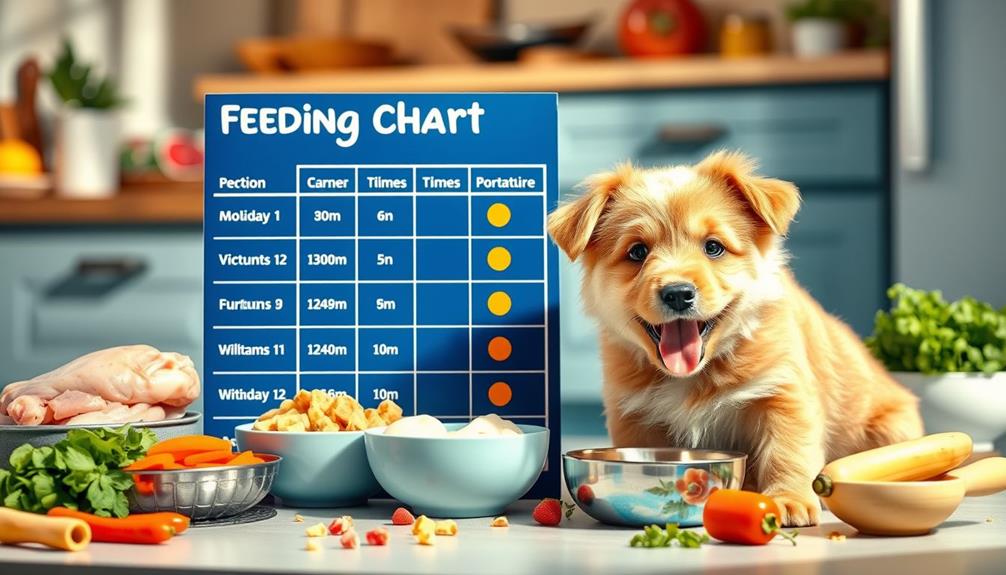
Establishing a feeding schedule based on your puppy's age is vital for their growth and development. When you start your puppy on a raw diet, it's important to take into account their nutritional needs at different stages, as providing proper nutrition can prevent health issues later in life.
Puppies aged 8 to 16 weeks should be fed four meals per day, supporting their rapid growth and high energy levels. As they shift to 16 weeks, you can change to three meals per day, since their growth rate begins to slow, but they still need ample food daily.
Financial considerations for elderly care can also highlight the importance of investing in a nutritious diet for long-term health benefits.
From 12 months onward, most puppies can handle two meals per day, though this may vary depending on their size and breed. It's important to feed your puppy an appropriate amount, typically ranging from 4% to 10% of their body weight. Younger puppies will require the higher percentage for ideal weight gain and development.
Regularly weigh your puppy and consult feeding charts to adjust their meal portions according to their age and growth stage. Following these feeding schedules will guarantee that your puppy thrives on their raw diet and develops into a healthy adult dog.
Monitoring Puppy Health
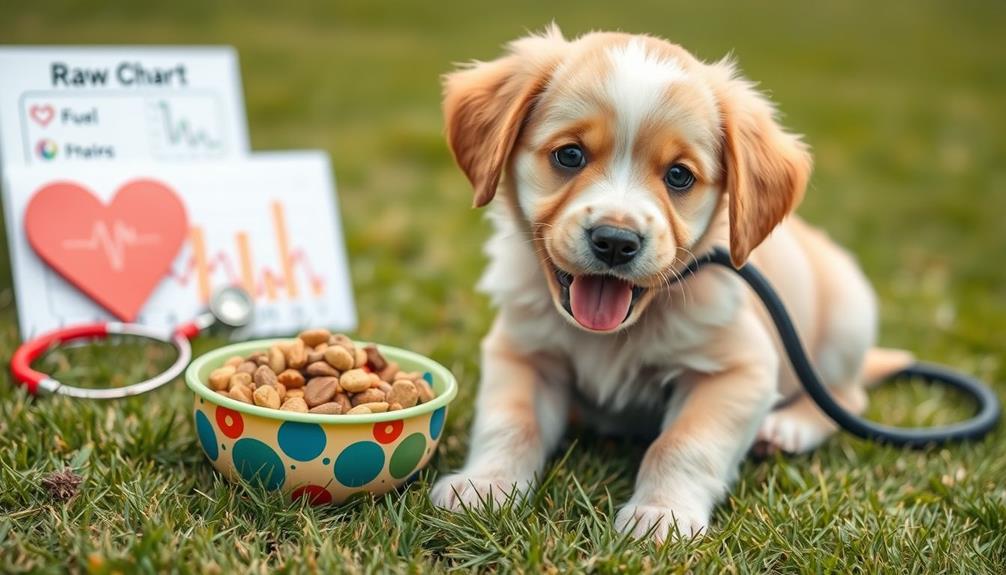
To guarantee your puppy's health, regularly assess their body condition, paying attention to their waistline and rib visibility.
It's also important to monitor their growth and development, as proper nutrition plays a vital role in key domains of development in psychology.
Keep an eye on stool consistency, as it can reveal important insights about their digestive health.
Body Condition Assessment
When it comes to monitoring your puppy's health, performing a Body Condition Assessment (BCA) is vital. A Body Condition Score (BCS) system, ranging from 1 to 9, helps you gauge your puppy's weight and overall health. Aim for a score of 4 to 5 for a healthy puppy, where ribs are palpable but not visible.
Maintaining a healthy body condition is essential, especially for active breeds, as it can influence their energy levels and overall well-being. For more insight into maintaining a clean environment for your puppy, consider looking into best vacuums for dust removal.
To effectively assess your puppy's condition, consider the following:
- Defined Waist: When viewed from above, your puppy should have a noticeable waist.
- Abdominal Tuck: From the side, a slight abdominal tuck indicates proper nutrition and body fat levels.
- Regular Weigh-Ins: Weigh your puppy weekly during their rapid growth phase to guarantee appropriate weight gain according to their breed standards.
- Adjust Feeding Amounts: Tailor feeding amounts based on your puppy's activity level and growth rate to maintain ideal weight.
Stool Consistency Monitoring
Monitoring your puppy's stool consistency is a key aspect of guaranteeing their digestive health. Ideally, you want firm and well-formed stools, as these indicate a balanced diet. If you notice loose stools, it may mean there's too much bone in the diet, and you might need to adjust the meat-to-bone ratio for best consistency.
Regular cleaning and avoiding irritants reduce infection chances, which is similar to maintaining hygiene for body piercings, as both require diligence to guarantee health and prevent complications body piercing hygiene.
Remember, when changing to a raw diet, some puppies may experience temporary loose stools. However, if this persists beyond a few days, it could signal food sensitivities or a diet imbalance that needs addressing.
On the other hand, hard stools might suggest excessive bone or not enough moisture in the diet, prompting a review of your feeding ratios or an increase in hydration sources.
Regular monitoring of your puppy's stool can also help identify potential allergies or food sensitivities. Keeping track of these changes allows you to make timely adjustments in protein sources or overall diet composition.
Energy Level Evaluation
Your puppy's energy levels are a vital indicator of their overall health and nutrition. Monitoring these levels can help you guarantee your puppy receives proper nutrition through a balanced raw diet.
Here's what to keep an eye on:
- Activity Levels: Regular play and exercise should be part of your puppy's routine. A lack of interest in play can signal health issues.
- Hydration: Always provide fresh water. Dehydration can lead to fatigue and impact energy levels.
- Nutrient Intake: Confirm your puppy's diet includes a variety of proteins and nutrients. Sudden changes in energy may indicate an imbalance.
- Behavior Changes: Watch for fluctuations in playful behavior. Increased lethargy or hyperactivity can be signs of dietary deficiencies or reactions to specific food sources.
Essential Components of a Raw Diet

A balanced raw diet for puppies is fundamental for their growth and development, consisting of key components that provide the necessary nutrients.
Ideally, about 69-71% of your puppy's diet should be muscle meat, which serves as the primary protein source. This muscle meat is critical for supplying the essential amino acids needed for proper growth and muscle development.
Incorporating 15-17% raw meaty bones in the diet is important to provide calcium and phosphorus, both of which support strong bone development.
Don't forget about organ meats; liver should make up 7% of the diet, while other organ meats can account for another 7%. These organs are packed with essential vitamins and minerals that are significant for overall health.
To guarantee a well-rounded, balanced diet, introduce a variety of protein sources and organ meats. This variety helps prevent nutritional deficiencies and promotes ideal puppy growth.
Dealing With Picky Eaters

Puppies can be notoriously picky eaters, making it essential to find effective strategies to encourage their appetite. Here are some tips to help you with feeding your raw puppy food:
- Rotate Protein Sources: Introduce variety by changing the protein every 3-4 days. Aim for at least four different proteins to boost nutrient absorption and keep meals exciting.
- Warm Up the Food: Slightly warming the raw food enhances its aroma, making it more tempting. You can also mix in small amounts of their favorite treats or toppers to increase interest.
- Monitor Stool Consistency: Keep an eye on your puppy's stool. Hard stools might mean you need to reduce bone content, while runny stools could indicate food intolerances or an imbalance that needs addressing.
- Ensure Freshness: Always serve fresh food to your puppy. Spoiled food can deter them from eating. Dispose of any leftovers promptly to prevent spoilage.
Safety and Preparation Tips
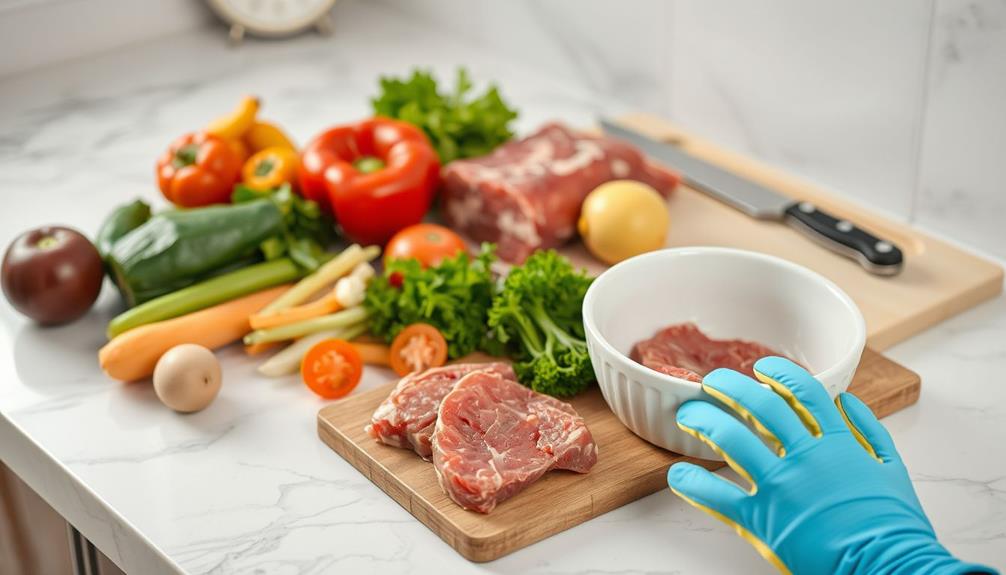
When feeding your puppy raw food, sourcing high-quality ingredients is essential for their health.
You'll also want to prioritize hygiene and safety practices to minimize any bacterial risks.
Additionally, proper food storage can help maintain freshness and prevent spoilage.
Proper Ingredient Sourcing
To guarantee your puppy thrives on a raw food diet, sourcing ingredients from reputable suppliers is essential. This guarantees you're providing high-quality, safe products free from harmful bacteria and contaminants.
Here are some key tips for proper ingredient sourcing:
- Choose organic or grass-fed options when selecting meats. These generally contain fewer additives and boast a higher nutrient profile.
- Always buy from trusted suppliers who prioritize animal welfare and quality control. Research local butchers, farmers' markets, or specialty pet food stores.
- Store raw food properly. Keep it in the freezer to maintain freshness and only thaw portions in the refrigerator, preventing bacterial growth during defrosting.
- Regularly monitor your puppy's health. Consult with a veterinarian to assess the raw diet's appropriateness and make necessary adjustments based on your puppy's needs.
Hygiene and Safety Practices
Maintaining strict hygiene and safety practices is vital for anyone feeding their puppy a raw food diet. Always use fresh food and high-quality ingredients to minimize the risk of bacterial contamination. When handling raw meat, wash your hands thoroughly, and clean all surfaces and utensils to prevent cross-contamination with other foods. Additionally, it’s important to properly store raw food in the refrigerator or freezer to prevent spoilage and bacterial growth. Make sure to follow specific guidelines and recommendations for feeding a puppy raw food to ensure they are receiving a balanced and nutritious diet. It’s also advisable to consult with a veterinarian or animal nutritionist when deciding to feed puppy raw food to ensure it is the best choice for their individual needs.
To guarantee food safety, store raw food in the freezer to preserve its freshness. When you're ready to serve, thaw the food safely in the refrigerator instead of at room temperature, which can promote bacterial growth. It's also essential to dispose of any uneaten raw food promptly to avoid spoilage and further bacterial proliferation.
Be mindful of the specific risks associated with raw feeding, particularly the potential for bacterial contamination. Implementing safe handling practices, like using separate cutting boards for raw meat and other ingredients, can help mitigate these concerns effectively.
Safe Food Storage
Storing raw puppy food properly is vital for keeping it fresh and safe. To guarantee safe food storage and prevent bacterial growth, follow these guidelines:
- Use airtight containers: Always store raw puppy food in airtight containers or vacuum-sealed bags. This helps maintain freshness and prevents contamination.
- Thaw raw food safely: When you need to thaw raw food, do so in the refrigerator. This slow defrosting minimizes the risk of bacterial contamination.
- Practice good hygiene: Clean all surfaces, utensils, and equipment after preparing raw food. This step is important to prevent cross-contamination with other foods.
- Dispose of uneaten raw food: If your puppy doesn't finish their meal, promptly discard any uneaten raw food. Never leave it out at room temperature for more than two hours.
Additionally, regularly check the expiration dates on your raw ingredients.
By practicing a first-in, first-out storage method, you'll guarantee older items are used before newer ones, keeping your puppy's diet safe and nutritious.
Following these steps will help you maintain a healthy feeding routine for your puppy while prioritizing food safety.
Community Resources and Support
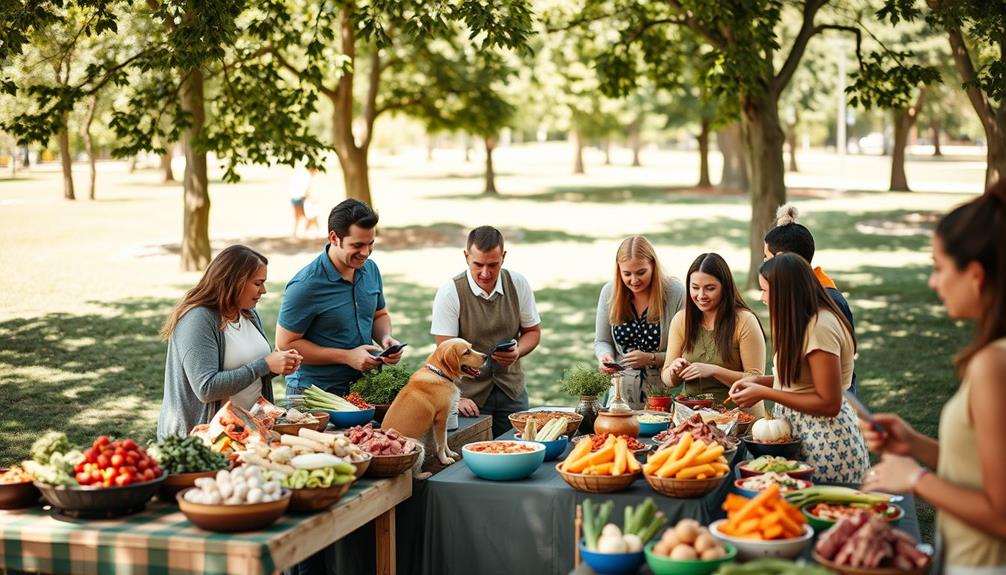
A wealth of community resources and support exists for those initiating the world of raw feeding for puppies. Joining online communities like "The Pack" can connect you with fellow pet owners who share their experiences and expert advice on raw feeding practices.
These platforms foster community engagement, allowing you to ask questions and receive real-time support from experienced raw feeders. Many groups offer valuable resources such as raw feeding calculators and meal planning tools, helping you tailor your puppy's diet to their specific nutrient intake needs.
Regular discussions about pet well-being and training tips can motivate you and reinforce your commitment to supporting healthy growth in your puppy. Engaging with others who are also guiding raw feeding provides a sense of belonging and reassurance.
Some communities even organize fun activities and Q&A sessions, giving you opportunities to learn directly from knowledgeable members. By tapping into these resources, you can confidently initiate your raw feeding journey, knowing you're not alone in this rewarding endeavor.
Frequently Asked Questions
What Are the Guidelines for Raw Feeding Puppies?
When raw feeding puppies, guarantee you balance muscle meat, bones, liver, and organs. Gradually shift over 7-10 days, monitor stool consistency, and adjust feeding frequency based on their age and activity levels.
How to Feed Raw Food to a Puppy?
You're diving into the wild world of raw feeding! Start by slowly mixing raw food with their current diet, then balance muscle meat, bones, and organs. Keep a watchful eye on their poops for ideal health!
How Much Raw Food to Feed a Puppy per Day?
You should feed your puppy about 10% of their body weight if they're 8 weeks old, gradually decreasing to 4% by 6 months. Adjust based on their growth and activity levels regularly.
At What Age Can You Start a Puppy on a Raw Diet?
You can start your puppy on a raw diet right after weaning, typically around 8 weeks old. This timing guarantees they get essential nutrients for growth and development, setting a strong foundation for their health.
Conclusion
As you watch your puppy thrive on a raw diet, imagine their shiny coat glistening in the sunlight and their playful energy bounding through the grass. Feeding them fresh, wholesome ingredients not only nourishes their growing bodies but also strengthens your bond. With patience and care, you'll see the joy in their eyes as they savor each bite. Embrace this journey, and together, you'll reveal a world of health and happiness for your furry friend.

